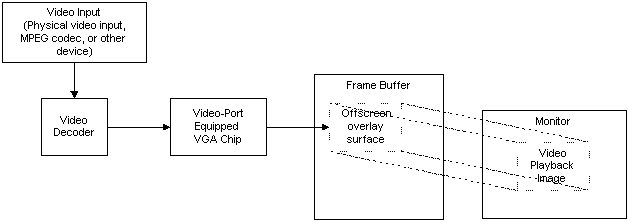 Important: Important: |
|---|
| This is retired content. This content is outdated and is no longer being maintained. It is provided as a courtesy for individuals who are still using these technologies. This content may contain URLs that were valid when originally published, but now link to sites or pages that no longer exist. |
A video port is hardware on a display device that enables direct access to a surface within the frame buffer, bypassing the CPU and PCI bus. Direct frame buffer access makes it possible to efficiently play live or recorded video without creating noticeable load on the CPU. Once in a surface, an image can be displayed on the screen as an overlay, used as a Direct3D texture, or accessed by the CPU for capture or other processing. The following paragraphs provide general information about the components that make up the technology and how they work.
Data Flow
In a machine equipped with a video port, data in a video stream can flow directly from a video source through a video decoder and the video port to the frame buffer. These components often exist together on a display adapter, but can be on separate hardware components that are physically connected to one another. An example of this data flow is provided in the following illustration.

Video source
In the scope of video-port technology, a video source is strictly a hardware video input device, such as a Zoom Video port, MPEG codec, or other hardware source. These sources broadcast signals in a variety of formats, including NTSC, PAL, and SECAM through a physical connection to a video decoder.
Video Decoder
A video decoder is also a hardware component. The video decoder's job is to decipher the information provided by the video source and send it to the video port in an agreed upon connection format. The decoder possesses a physical connection to the video port, and exposes its services through a stream class minidriver. The decoder is responsible for sending video data and clock and sync information to the video port.
Video port
Like the other components in the data flow path, the video port is a piece of hardware. The video port exists on the display adapter's VGA chip and has direct access to the frame buffer. It receives information sent from the decoder, processes it, and places it in the frame buffer to be displayed. During processing, the video port can manipulate image data to provide scaling, shrinking, color control, or cropping services.
Frame Buffer
The frame buffer accepts video data as provided by the video port. Once received, applications can programmatically manipulate the image data, blit it to other locations, or show it on the display using an overlay (the most common use).
Last updated on Tuesday, May 18, 2004